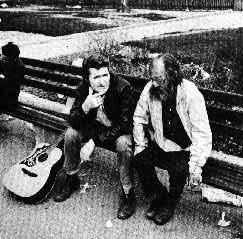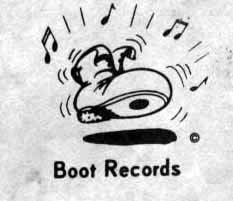
Page 3
Stevedore Steve: phase one

They came up with moniker Stevedore Steve because they wanted an angle, a hook to market him with now that he was a Dominion Records recording artist. They also wanted something with a definite east-coast flavour to it, thus the songs were all centred around the Maritime seas. Steve was delirious about having his own album out and went along with it all. He was proud to call himself "Stevedore Steve". This marketing ploy proved to be hugely successful as it lead to better paying jobs before all sorts of audiences.
It was at this time that Steve took up residence in Toronto. He had fathered a son (wasn't living with the boy's mother in Saint John) and was soon to meet his destined partner in life: Gini Brooksbank, from Hamilton, Ontario.
Gigging, in those days, was the only sure way to sell records. There was very little infrastructure in the Canadian music business; distribution networks were controlled by one or two companies. There was no CRTC Canadian Content rules, and it was nearly next to impossible to get Canadian country music played by Canadian radio stations. Playing gigs, selling from the stage, that was basically how it was done.
It was a hard grind but for the first time in his life, Steve Foote was on the road to something big, and he could feel it. What made it bearable for him was the companionship of his new mate, Gini. They married and honeymooned in Britt, Ontario, the place where he wrote the song called Log Drive On The Pickerell. Steve and Gini seemed inseparable, they went everywhere together, to every gig, working from their panel van for weeks on end.
"Gini and I have been married now going on about eight and a half years and we've been on the road together all that time. But Gini is not on the show or anything like that. She's the world's greatest moral support, and she's in my audience all the time. She's heard all my cornball jokes over and over, she's heard all my songs and she listens to them, I think, just as intently now as when I just wrote them." 1
While much has been said over the years about "The Circuit" - the infamous Ontario bar circuit, which was even more infamous in the towns of Northern Ontario and Quebec - The Stevedore seemed to thrive in those places. His was a solo act. He would be booked into hotels following weeks of bar bands and would somehow manage to grab the place by the tail. But it was always a tough job; you never knew what the state of the audience was going to be like on any given night, and you could be quite sure that on some nights no-one was paying the slightest attention to the songs; they just wanted entertainment to talk over. To drink their beer and argue to.
"I don't really like playing clubs, beer joints, shooting galleries, and all that stuff. I like meeting people, but when they're sober, you know. I love one-nighters: the people come out to hear their favourite song by whom-ever the artist is, or maybe they come out to see the artist for the first time or whatever. But they come out to listen. In clubs it's different. In clubs, fifty per cent of the audience is there to either hustle themselves up a chick or a guy. Somebody else is there on business. And some of them are there just because it's booze time - let's get filled up. Once in a while somebody'll come in that knows you, and wants to hear you, but that's pretty seldom. Rest of the time, you're just there." 2The long, hard hours at a gruelling pace eventually paid off. Steve and Gini found it difficult to keep enough records in stock. Since the company found it difficult to distribute them to places like Hawke Junction, Foleyet, Des Jochimes (known as The Swisha), where there were no record selling stores, selling from the stage was the only guarantee that fans would be able to buy them. It depended on the sincerity of one's on-stage presence. The fact that Steve respected his audiences and treated them thus; that his product - his songs - were well crafted, countrified folk songs, made him popular with his increasing fan base.
"No 'phoney sophistication'
for singer Stevedore Steve", read the headline in the London  Free
Press.3 "My
songs are honest, they're not phoney sophistication," he is quoted as saying.
Free
Press.3 "My
songs are honest, they're not phoney sophistication," he is quoted as saying.
While Tom Connors and
Jury Krytiuk were formulating their future partnership, acquiring much
of the Dominion Records catalogue of acts, it was obvious that they had
their eyes on Stevedore Steve to be one of Boot Records' premiere acts.
Krytiuk, in an email sent to me, clarified how this happened:

(The official logo of Boot Records, drawn by Steve Foote)
Stompin' Tom already had several of his own recordings released on Boot and was gaining popularity by leaps and bounds. He was a star born of red dust and tubers with a set of tires. He was featured on television, would have his own national CBC television program, would release a film called "Across This Land With Stompin' Tom Connors". He and Jury would formulate a clever strategy to allow him maximum exposure for major endeavors, like getting married on the Elwood Glover's CBC TV show 'Luncheon Date', or by riding on a spud truck through the streets of Charlottetown and being presented with a golden spud by the Premier of that province. They capitalized as well on other photo-ops and news scoops, boosting the image of Stompin' Tom on a national scale unprecedented in the Canadian music business. Stompin' Tom Connors became one of the most recognizable Canadian figures of the day, a pop icon that reverberated with fresh nationalistic qualities, putting real people in real places on the charts and maps.5
While all this was happening, Stevedore Steve was quietly getting into gear, scoring points which would eventually lead to his own weekly TV program on Moses Znaimer's then fledgeling CITY-TV station in Toronto.
With the release of his second album for Boot Records, I've Lived, Steve was about to hit the big time in Canadian country music. It seemed as though Boot Records had another popular star on their hands.
Notes:
1. Singin' About Us, Stevedore
Steve Foote, 1976
2. Singin' About Us
3. Article in London Free
Press, September 12, 1973 by Silvio Dorre
4. Email from Juri Krytiuk
entitled A SLIGHT ERROR, January 1, 1998
5. Voted the 13th most famous
Canadian for the CBC television poll in the early 2000s. He was the highest
rated performer, out-doing Celine Dion, Shania Twain, Gordon Lightfoot,
and anyone else. Canada Post Corporation issued a Stompin' Tom postage
stamp in June, 2009.
Back to the Index
To go read about the Lester the Lobster
phase of the career of Stevedore Steve, click HERE
© 2003 by Steve Fruitman
for The Great North Wind ®